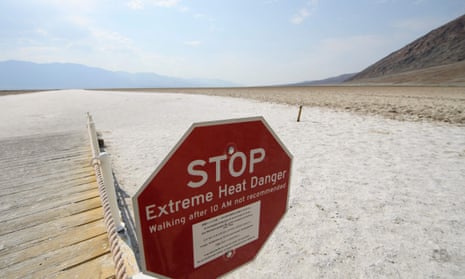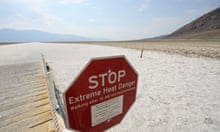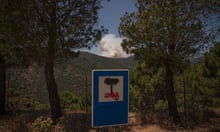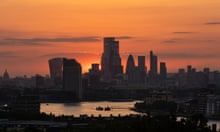Millions across the US south-west are bracing for a weekend of sweltering heat as forecasts threaten record-setting high temperatures that will top 100F in several states.
Heat advisories and excessive heat warnings have been issued across portions of roughly half a dozen states and daily records could be broken in more than 75 cities.
In areas across California, the Great Basin, the south-west, and Texas, daytime temperatures are expected to spike 10 to 20 degrees above normal, according to a Friday forecast from the National Weather Service, which has issued warnings or advisories in areas that affect close to 38 million people. Night-time temperatures will offer little reprieve, escalating the health-related risks of the first extreme heat event in what’s shaping into yet another scorching summer.
First Record of the Heatwave!
— NWS Las Vegas (@NWSVegas) June 10, 2022
🥵🌡️☀️
Needles, CA struggled to cool off last night, only cooling down to 87F... tying their previous warm low record for June 9th. 😳
Previous record was 2016.#NeedlesWxRecords pic.twitter.com/qWqTgqnETv
Spiking temperatures will also set the stage for a set of compounding catastrophes across the west, baking moisture out of already parched landscapes. Roughly 44% of the American west is categorized as in extreme drought this week, according to the US Drought Monitor. The punishing weather also increases the risks for wildfire ignitions and contributes to worsening air quality.
“Elevated temperatures, which enhance ozone formation rates and increase emissions of chemicals leading to ozone formation, coupled with predicted light winds may cause unusually high and persistent levels of ozone pollution,” the South Coast air quality management district said in a heatwave advisory, warning that poor air quality is expected to persist in areas across southern California through the weekend.
In Arizona, Phoenix and Yuma are forecast to be just shy of 115F (46C) on Saturday when the heat peaks across the region. Blythe and El Centro in California will be at or above that temperature. Las Vegas will top out at 111F (44C) during the heatwave, the National Weather Service said.
The dangerous conditions come as summer recreation and outdoor activities begin to ramp up, but officials have cautioned residents and visitors in impacted areas to stay out of the elements. Heeding their calls, the University of California, Davis called off its commencement ceremony on Friday while it was under way. The school has scheduled a separate event for them on Sunday.
I'm getting multiple reports that grads and family members at UC Davis' commencement suffered heat exhaustion—with some requiring medical attention. Hopefully nothing too serious. Ceremony was cut short before many grads had crossed the stage.
— Caleb Hampton (@calebmhampton) June 10, 2022
Extreme heat events are expected to grow in both frequency and intensity over the coming decades, fueled by the climate crisis. Models indicate that there could be between 25 and 30 extreme events a year by mid-century – up from an average of between four and six a year historically – and that they will also cover wider swaths of land regionally than before.
An often silent killer that takes more lives than any other kind of extreme weather, rising temperatures pose significant risks to public health that will worsen as the world warms. An investigation by the LA Times published last year found that fatalities from heat are abysmally undercounted in California, and that related deaths could be as much as six times higher than the official tally.
Officials have cautioned residents to prepare. “Drink plenty of fluids, stay in an air-conditioned room, stay out of the sun, and check up on relatives and neighbors,” the National Weather Service warned, adding that children and pets should never be left in cars unattended.
While heat is dangerous for all, the effects of spiking temperatures are felt most acutely among vulnerable populations, including people without homes and workers who labor outside. Homeless people are about 200 times more likely to die from heat-associated causes, said David Hondula, a climate scientist who leads the city of Phoenix’s office of heat response and mitigation.
“We’ve had some prior heatwaves this year, but not as intense as this one or as long duration,” National Weather Service meteorologist Alex Tardy said in a video briefing, noting that the hottest days will be Friday and Saturday, but that warmer weather will continue into mid-month. “These are significant temperatures and temperatures that are dangerous to everyone, if you don’t take precautions.”
The Associated Press contributed reporting






